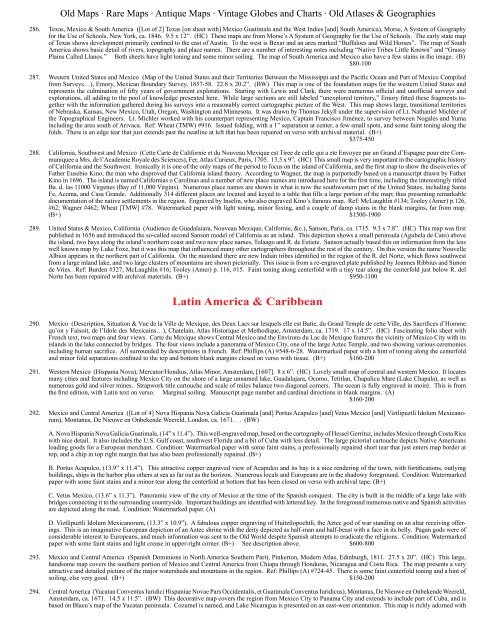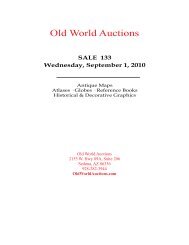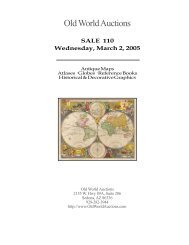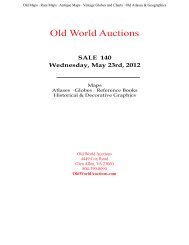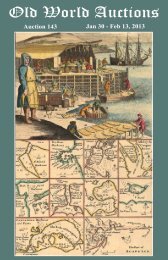<strong>Old</strong> Maps · Rare Maps · Antique Maps · Vintage Globes and Charts · <strong>Old</strong> Atlases & Geographies286. Texas, Mexico & South America ([Lot of 2] Texas [on sheet with] Mexico Guatimala and the West Indies [and] South America), Morse, A System of Geographyfor the Use of Schools, New York, ca. 1846. 9.5 x 12”. (HC) These maps are from Morse’s A System of Geography for the Use of Schools. The early state mapof Texas shows development primarily confined to the east of Austin. To the west is Bexar and an area marked “Buffaloes and Wild Horses”. The map of SouthAmerica shows basic detail of rivers, topography and place names. There are a number of interesting notes including “Native Tribes Little Known” and “GrassyPlains Called Llanos.” Both sheets have light toning and some minor soiling. The map of South America and Mexico also have a few stains in the image. (B)$80-100287. Western United States and Mexico (Map of the United States and their Territories Between the Mississippi and the Pacific Ocean and Part of Mexico Compiledfrom Surveys…), Emory, Mexican Boundary Survey, 1857-58. 22.8 x 20.2”. (BW) This map is one of the foundation maps for the western United States andrepresents the culmination of fifty years of government explorations. Starting with Lewis and Clark, there were numerous official and unofficial surveys andexplorations, all adding to the pool of knowledge presented here. While large sections are still labeled “unexplored territory,” Emory fitted these fragments togetherwith the information gathered during his surveys into a reasonably correct cartographic picture of the West. This map shows large, transitional territoriesof Nebraska, Kansas, New Mexico, Utah, Oregon, Washington and Minnesota. It was drawn by Thomas Jekyll under the supervision of Lt. Nathaniel Michler ofthe Topographical Engineers. Lt. Michler worked with his counterpart representing Mexico, Captain Francisco Jiménez, to survey between Nogales and Yumaincluding the area south of Arivaca. Ref: Wheat (TMW) #916. Issued folding, with a 1” separation at center, a few small spots, and some faint toning along thefolds. There is an edge tear that just extends past the neatline at left that has been repaired on verso with archival material. (B+)$375-450288. California, Southwest and Mexico (Cette Carte de Californie et du Nouveau Mexique est Tiree de celle qui a ete Envoyee par un Grand d’Espagne pour etre Communiqueea Mrs. de l’Academie Royale des Sciences), Fer, Atlas Curieux, Paris, 1705. 13.5 x 9”. (HC) This small map is very important in the cartographic historyof California and the Southwest. Ironically it is one of the only maps of the period to focus on the island of California, and the first map to show the discoveries ofFather Eusebio Kino, the man who disproved that California island theory. According to Wagner, the map is purportedly based on a manuscript drawn by FatherKino in 1696. The island is named Californias o Carolinas and a number of new place names are introduced here for the first time, including the interestingly titledBa. d. las 11000 Virgenes (Bay of 11,000 Virgins). Numerous place names are shown in what is now the southwestern part of the United States, including SantaFe, Acoma, and Casa Grande. Additionally 314 different places are located and keyed to a table that fills a large portion of the map; thus presenting remarkabledocumentation of the native settlements in the region. Engraved by Inselin, who also engraved Kino’s famous map. Ref: McLaughlin #134; Tooley (Amer) p.126,#62; Wagner #462; Wheat [TMW] #78. Watermarked paper with light toning, minor foxing, and a couple of damp stains in the blank margins, far from map.(B+) $1500-1900289. United States & Mexico, California (Audience de Guadalaiara, Nouveau Mexique, Californie, &c.), Sanson, Paris, ca. 1715. 9.3 x 7.8”. (HC) This map was firstpublished in 1656 and introduced the so-called second Sanson model of California as an island. This depiction shows a small peninsula (Agubela de Cato) abovethe island, two bays along the island’s northern coast and two new place names, Tolaago and R. de Estiete. Sanson actually based this on information from the lesswell known map by Luke Foxe, but it was this map that influenced many other cartographers throughout the rest of the century. On this version the name NouvelleAlbion appears in the northern part of California. On the mainland there are new Indian tribes identified in the region of the R. del Norte, which flows southwestfrom a large inland lake, and two large clusters of mountains are shown pictorially. This issue is from a re-engraved plate published by Joannes Ribbius and Simonde Vries. Ref: Burden #327; McLaughlin #16; Tooley (Amer) p. 116, #15. Faint toning along centerfold with a tiny tear along the centerfold just below R. delNorte has been repaired with archival materials. (B+) $950-1100Latin America & Caribbean290. Mexico (Description, Situation & Vue de la Ville de Mexique, des Deux Lacs sur lesquels elle est Batie, du Grand Temple de cette Ville, des Sacrifices d’Hommequ’on y Faisoit, de l’Idole des Mexicains…), Chatelain, Atlas Historique et Methodique, Amsterdam, ca. 1719. 17 x 14.5”. (HC) Fascinating folio sheet withFrench text, two maps and four views. Carte du Mexique shows Central Mexico and the Environs du Lac de Mexique features the vicinity of Mexico City with itsislands in the lake connected by bridges. The four views include a panorama of Mexico City, one of the large Aztec Temple, and two showing various ceremoniesincluding human sacrifice. All surrounded by descriptions in French. Ref: Phillips (A) #548-6-28. Watermarked paper with a hint of toning along the centerfoldand minor fold separations confined to the top and bottom blank margins closed on verso with tissue. (B+) $160-200291. Western Mexico (Hispania Nova), Mercator/Hondius, Atlas Minor, Amsterdam, [1607]. 8 x 6”. (HC) Lovely small map of central and western Mexico. It locatesmany cities and features including Mexico City on the shore of a large unnamed lake, Guadalajara, Ocomo, Tetitlan, Chapalicu Mare (Lake Chapala), as well asnumerous gold and silver mines. Strapwork title cartouche and scale of miles balance two diagonal corners. The ocean is fully engraved in moiré. This is fromthe first edition, with Latin text on verso. Marginal soiling. Manuscript page number and cardinal directions in blank margins. (A)$160-200292. Mexico and Central America ([Lot of 4] Nova Hispania Nova Galicia Guatimala [and] Portus Acapulco [and] Vetus Mexico [and] Viztlipuztli Idolum Mexicanorum),Montanus, De Nieuwe en Onbekende Weereld, London, ca. 1671. . (BW)A. Nova Hispania Nova Galicia Guatimala, (14” x 11.4”). This well-engraved map, based on the cartography of Hessel Gerritsz, includes Mexico through Costa Ricawith nice detail. It also includes the U.S. Gulf coast, southwest Florida and a bit of Cuba with less detail. The large pictorial cartouche depicts Native Americansloading goods for a European merchant. Condition: Watermarked paper with some faint stains, a professionally repaired short tear that just enters map border attop, and a chip in top right margin that has also been professionally repaired. (B+)B. Portus Acapulco, (13.9” x 11.4”). This attractive copper engraved view of Acapulco and its bay is a nice rendering of the town, with fortifications, outlyingbuildings, ships in the harbor plus others at sea as far out as the horizon. Numerous locals and Europeans are in the shadowy foreground. Condition: Watermarkedpaper with some faint stains and a minor tear along the centerfold at bottom that has been closed on verso with archival tape. (B+)C. Vetus Mexico, (13.6” x 11.3”). Panoramic view of the city of Mexico at the time of the Spanish conquest. The city is built in the middle of a large lake withbridges connecting it to the surrounding countryside. Important buildings are identified with lettered key. In the foreground numerous native and Spanish activitiesare depicted along the road. Condition: Watermarked paper. (A)D. Viztlipuztli Idolum Mexicanorum, (13.3” x 10.9”). A fabulous copper engraving of Huitzilopochtli, the Aztec god of war standing on an altar receiving offerings.This is an imaginative European depiction of an Aztec shrine with the deity depicted as half-man and half-beast with a face in its belly. Pagan gods were ofconsiderable interest to Europeans, and much information was sent to the <strong>Old</strong> <strong>World</strong> despite Spanish attempts to eradicate the religions. Condition: Watermarkedpaper with some faint stains and light crease in upper-right corner. (B+) See description above. $600-800293. Mexico and Central America (Spanish Dominions in North America Southern Part), Pinkerton, Modern Atlas, Edinburgh, 1811. 27.5 x 20”. (HC) This large,handsome map covers the southern portion of Mexico and Central America from Chiapa through Honduras, Nicaragua and Costa Rica. The map presents a veryattractive and detailed picture of the major watersheds and mountains in the region. Ref: Phillips (A) #724-45. There is some faint centerfold toning and a hint ofsoiling, else very good. (B+) $150-200294. Central America (Yucatan Conventus Iuridici Hispaniae Novae Pars Occidentalis, et Guatimala Conventus Iuridicus), Montanus, De Nieuwe en Onbekende Weereld,Amsterdam, ca. 1671. 14.5 x 11.5”. (BW) This decorative map covers the region from Mexico City to Panama City and extends to include part of Cuba, and isbased on Blaeu’s map of the Yucatan peninsula. Cozumel is named, and Lake Nicaragua is presented on an east-west orientation. This map is richly adorned with
<strong>Old</strong> Maps · Rare Maps · Antique Maps · Vintage Globes and Charts · <strong>Old</strong> Atlases & Geographiesships engaged in battle, Neptune and his entourage, and an elaborate title cartouche with Natives, putti, and a large shell. Watermarked paper with light toning.(B+) $400-500295. Central America (Nouvelle Espagne, Nouvelle Galice, et Guatimala, dans l’Amerique Septentrionale…), Aa, Leiden, ca. 1729. 14 x 11.3”. (HC) This decorativemap of Central America depicts the majority of Mexico through Costa Rica, and extends to include part of the coastline of the US to Florida and Cuba. Cities, rivers,mountains and even volcanoes are illustrated. The title cartouche features a large architectural structure surmounted by weaponry, with Native Indians tradingwith a European on the right and a sailing ship in the background. A strong impression on watermarked paper with wide margins, a few minor printer’s creases,printer’s ink residue, and some tiny abrasions. (B+) $600-700296. Central America (Partie Meridionale, de l’Ancien Mexique ou de la Nouvle. Espagne), Bonne, Raynal’s Atlas de toutes les parties connues du globe terrestre,Paris, ca. 1783. 12.5 x 8.2”. (HC) This attractive copper engraved map covers southern Mexico and all of Central America. Detail includes towns and villages,rivers, mountains, shoals and navigational hazards along the coasts. (A) $100-130297. Central America, Panama (The Rand-McNally New Commercial Atlas Map of Panama…), Rand McNally & Co., Chicago, 1912. 25.8 x 19”. (PC) This is avery early commercial pocket map of Panama and the Canal Zone. The various departments are delineated along with an inset map of the Canal Zone and a profileview of the Canal showing the land that was cut away to facilitate the canal. The verso has an index of towns, rivers and mountains along with details of the Canal.The United States took over the French efforts to build the canal in 1904 and finally completed construction in January of 1914. Thus this map actually predatesthe completed canal and attests to the strategic and economic importance of this technological marvel. The map folds into original blue cloth covers. There isarchival tape on verso to reinforce a few fold intersections, else fine. (A) $180-220298. Panama (Plan de la Baye et Ville de Portobelo en 1736), Bellin, Prevost’s Histoire Generale des Voyages, Paris, ca. 1750. 12.8 x 7.5”. (BW) This attractive chartshows Portobelo, the important Spanish port city on the northern coast of Panama. Numerous soundings are located and a key at right identifies important locations.The chart is surrounded by a boldly engraved border. There is a hint of offsetting in the image and a few small extraneous creases. Issued folding. (B+)$120-150299. Panama (Carte de l’Isthme de Panama et des Provinces de Veragua Terre Ferme et Darien…), Bellin, L’Histoire Generale des Voyages, Paris, 1754. 11.25 x 7.75”.(HC) An attractive, small map featuring good detail of Panama many years before the creation of the Canal and Lake Bayano. Numerous place names includingS. Yago on the Azuevo Peninsula, Portobelo, Se. Marie, Panama, etc. Extends to include the Gulf of Darien. Adorned with a delicate title cartouche. This mapwas published in Antoine Francois Prevost d’Exiles’ influential collection of travel narratives, L’Histoire Generale des Voyages. A faint damp stain at left withtwo minor printer’s creases. (B+) $190-220300. Caribbean and Mexico (Culiacanae, Americae Regionis Descriptio [on sheet with] Hispanoliae, Cubae, Aliarumque Insularum Circumiacientium, Delineato), Ortelius,Theatrum Orbis Terrarum, Antwerp, 1579. 19.5 x 14”. (HC) Two great early maps of important regions in the New <strong>World</strong> are combined into this interestingcomposition. The first covers the region of western Mexico around Culiacan and the Spanish settlement of Villa S. Michael’s, the region noted for its silver mines.The second is the first detailed map of the Greater Antilles with detail in southern Florida, the Bahamas, and the Caribbean that is quite remarkable for the period.Ortelius based the maps on a variety of sources including Mercator’s world map (1569) and other maps by Gutters and Alone De Santa Cruz. Three strapworkcartouches and sailing ships decorate the map. Latin text on verso, published between 1592-1612. Ref: Van den Broecke #14. Attractive color with gilt highlightson watermarked paper and short centerfold separations in blank margins that have been archivally repaired. (A) $1200-1400301. Gulf of Mexico and Caribbean (A New and Accurate Chart of the West Indies with the Adjacent Coasts of North and South America…), Bowen, John Harris’Navigantium Atque…, Philadelphia, ca. 1744. 17.8 x 14.5”. (HC) A handsome map of the Caribbean and Gulf coasts with well engraved detail and many remarkson sailing directions, history, and native populations. The trade winds are noted with directional arrows, and the major trade routes are delineated. The coastalplace names are abundant, with some towns and fortifications named inland. An early reference to the first attempted colony in Texas is Cenis Ft. on the banks ofthe Trinity River. In today’s Colombia are noted Gold Rivers and Mines and a Dutch Colony is located in Surinam. The map is filled with extensive, interestingnotations on the Spanish Galleons, John Oxnam and the Isthmus of Darien, King Charles II and the granting of the Carolina charter, and much more. A decorativecartouche and two compass roses complete the composition. Ref: Shirley (BL Atlases) G.HARR-1a #17. Just a hint of toning along centerfold. (B+)$750-850302. Gulf of Mexico and Caribbean (Carte du Golphe du Mexique et des Isles de l’Amerique), Bellin, Prevost’s Histoire Generale des Voyages, Paris, 1754. 14.9 x10.7”. (HC) Attractive map of the islands of the Caribbean with the parts of the United States and Mexico that border the Gulf of Mexico, Central America, andthe northern coastline of South America. Routes of several explorers are shown, including Cortez, Ponce de Leon, and Hernandez de Cordova, along with manycoastal place names. A delicately engraved rococo-style title cartouche fills the upper right. Ref: cf Sellers & Van Ee #1683. Issued folding, now pressed onwatermarked paper and backed in tissue to reinforce folds. Expertly remargined at right with a small amount of neatline in facsimile at bottom. (B+)$200-240303. Gulf of Mexico and Caribbean (Map of the Gulf of Mexico, the Islands and Countries Adjacent), Kitchin, Robertson’s History of America, London, 1777. 19.3x 12.5”. (BW) Lovely copper engraved map covering the region from Florida and the Gulf coast to northern South America. The southern portion of Floridais fragmented into numerous waterways. There is crisp detail of the many islands, the South American coast and Central America. Decorative rococo-style titlecartouche and compass rose. Published by W. Strahan and T. Cadell. Ref: Howes #R358. Issued folding with a couple of minute separations at fold intersectionsand faint offsetting. (B+) $180-220304. Gulf of Mexico and Caribbean (A General Chart of the West Indies / To His Royal Highness George Augustus Frederick Prince of Wales &c. &c. &c. this Chart ofthe West Indies, is Humbly Inscribed…), Speer, London, 1796. 45.5 x 28.3”. (HC) This impressive large-scale chart of the Gulf of Mexico includes the southernUnited States, Central America, the West Indies, and northern South America. A table at far right lists the colonial possessions of the English, French, Spanish,Dutch and Danish, and gives direction as to how they should be colored on the chart. The United States boundaries reflect the 1796 Pinckney’s Treaty, extendingto the Mississippi River in the west and south to northern Florida. Pinckney’s Treaty, also known as the Treaty of San Lorenzo or the Treaty of Madrid, defined theboundaries of the United States, gave the U.S. navigation rights on the Mississippi River, and established intentions of friendship between the United States andSpain. The Spanish possessions west of the Mississippi are left largely blank, with Ticas (Texas), Wandering Indians, and A Vast Tract of Unknown Land noted.Political boundaries, cities, forts, Indian tribal territories, and topographical details are well depicted. The waters are filled with soundings, navigational hazards,arrows identifying the direction of trade winds, and the routes of the Spanish gold fleet. The Pacific Ocean is filled with a large rococo-style cartouche dedicatingthe map to George Augustus Frederick, Prince of Wales, who became the King of the United Kingdom of Great Britain and Ireland in 1820. There is an engravedendorsement by John Pownall, Secretary to the Plantation Office, certifying that the chart incorporates the “latest and most accurate surveys.” The map was firstpublished in 1774; this is the second state republished by Robert Wilkinson, with an “Honorary Gold Medal” seal given to Speer and engraved just above SouthAmerica. Engraved by Thomas Bowen. On two sheets, joined.Captain Joseph Smith Speer was an officer in the Royal Navy who spent many years in the West Indies. His most famous work, the West-India Pilot, contained 13maps of the region, published in 1766, followed by an extended 26-map edition in 1771. Ref: Sellers & Van Ee #1699. <strong>Old</strong> color with light offsetting and a fewfaint damp stains. There are a few fold separations between the 11th and 12th parallels and in South America that were previously closed with cello tape, causingsome discoloration. The cello tape has been removed and the separations have all been closed with archival materials. A 1” tear just below Honduras, a smallhole near New Leon, and a small hole east of the Bahamas have also all been archivally repaired. There is a tiny pinhole in the Gulf of Mexico. Despite theseimperfections, this is a good example of such a large and rare map. (B) $3750-5000305. Gulf of Mexico and Caribbean (Carte des Cotes du Golfe du Mexique Compris entre la Pointe Sud de la Presqu’Ile de la Floride et la Pointe Nord de la Presqu’Iled’Yucatan…), Depot de la Marine, Paris, 1800. 35.8 x 23.8”. (HC) This is one of the earliest charts to name the bays of Galveston and Bernardo (now Matagorda)in Texas. This French edition was published just one year after the map on which it was based: Carta Esferica que Comprehende las Costas del Seno Mexicano


